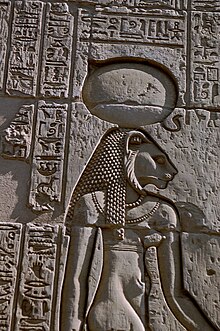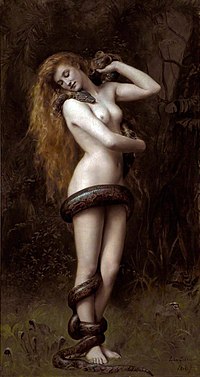User:Spawn Man/Sandbox
Welcome to My sandbox, a collection of my recent workings & draughts for articles & pages on Wikipedia. -- Spawn Man

The Ancient Egyptian goddess Sekhmet was closely associated with bloodlust, death, and vampiric behaviour derived from her role in an older legend known as The Revenge of Ra. Possessing the head of a lion, Sekhmet was considered the greatest hunter known to the Egyptians and was originally the warrior goddess of Upper Egypt, who devoured humans and drank blood after battle. She was closely related with the warrior goddess Bast, but was often depicted as the fiercer of the two, with names such as Lady of Slaughter, Mistress of Dread, Avenger of Wrongs, and the Scarlet Lady. Sekhmet was usually shown in red was seen as a special goddess for women as well as a patron god of menstruation. In The Revenge of Ra, she was created by Ra in order to take vengeance on mankind after he found them to be plotting against him. She soon had destroyed most of mankind, devouring humans and drinking blood. However, Ra relented and ordered her to cease destroying the land; Sekhmet refused, now thirsty for more blood and no longer wishing to listen to Ra. Fearing the worst, Ra decided to trick her by turning the Nile red as if it were blood. Sekhmet went to drink the river, but when she did so Ra turned the red water into beer, intoxicating the goddess; Sekhmet fell asleep and awoke much later, having forgotten why she was on earth. She returned to Ra[1] and turned into a more benign god named Hathor.[2]
There are many variations on this legend; one is that Sekhmet drank the Nile in order to save the world from its overflowing waters. Another is that it was the humans, not Ra, that turned the Nile River red, with beer mixed with pomegranate, in order to stop her bloodlust. Whatever the case, the legend is closely linked to the Nile's own flood cycle; at the beginning of each calendar year during the river's inundation, the Nile is often laden with sand and silt from the lands upstream, giving the water a red, blood-like appearance due to the Arabian sand's red properties. This depiction gave rise to Sekhmet's portrayal as a vampiric being in later mythology.[1] In order to appease the goddess, a special festival was held by the Ancient Egyptians each year during the Nile's inundation, where records show that thousands of followers attended. At the festival, all the alcohol was coloured red in her honour.[2]
Ancient beliefs
[edit]
Tales of the undead consuming the blood or flesh of living beings have been found in nearly every culture around the world for many centuries.[3] Today we know these entities predominantly as vampires, but in ancient times, the term vampire did not exist; blood drinking and similar activities were attributed to demons or spirits who would eat flesh and drink blood; even the devil was considered synonymous with the vampire.[4] Almost every nation has associated blood drinking with some kind of revenant or demon. The Ancient Indian deity Kali with fangs, and a garland of corpses or skulls, was intimately linked with the drinking of blood.[5] Tales of vetalas, ghoul-like beings that inhabit corpses, have been compiled in the Baital Pachisi, a prominent story in the Kathasaritsagara tells of King Vikramāditya and his nightly quests to capture an elusive one.[6] Pishacha, the returned spirits of evil-doers or those who died insane, also bear vampiric attributes.[7] Even Egypt had its blood-drinking goddess Sekhmet. Indeed, some of these legends could have given rise to the Eastern European folklore, though they are not strictly considered vampires by historians when using today's definitions.[8][9]
Mesopotamia
[edit]Mesopotamia was an area rampant with superstition of blood-drinking demons. The Persians were one of the first civilizations thought to have tales of blood-drinking demons: creatures attempting to drink blood from men were depicted on excavated pottery shards.[8] Ancient Babylonia had tales of the mythical Lilitu,[10] synonymous with and giving rise to Lilith (Hebrew לילית) and her daughters the Lilu from Hebrew demonology. Lilitu was considered a demon and was often depicted as subsisting on the blood of babies. However, the Jewish counterparts were said to feast on both men and women, as well as newborns.[10] The legend of Lilith was originally included in some traditional Jewish texts: according to the medieval folk traditions, she was considered to be Adam's first wife before Eve.[11][12] In these texts, Lilith left Adam to become the queen of the demons and, much like the Greek striges, would prey on young babies and their mothers at night, as well as males. Because Hebrew law absolutely forbade the eating of human flesh or the drinking of any type of blood, Lilith's blood drinking was described as exceptionally evil. To ward off attacks from Lilith, parents used to hang amulets from their child's cradle.[12]
An alternate version states the legend of Lilith/Lilitu (and a type of spirit of the same name) originally arose from Sumer, where she was described as an infertile "beautiful maiden" and was believed to be a harlot and vampire who, after having chosen a lover, would never let him go.[13] Lilitu (or the Lilitu spirits) was considered to be an anthropomorphic bird-footed, wind or night demon and was often described as a sexual predator who subsisted on the blood of babies and their mothers.[12] Other Mesopotamian demons such as the Babylonian goddess Lamashtu, (Sumer's Dimme) and Gallu of the Uttuke group are mentioned as having vampiric natures.[14][15]
Lamashtu is a historically older image that left a mark on the figure of Lilith.[16] Many incantations invoke her as a malicious "Daughter of Heaven" or of Anu, and she is often depicted as a terrifying blood-sucking creature with a lion's head and the body of a donkey.[17] Akin to Lilitu, Lamashtu primarily preyed on newborns and their mothers.[18] She was said to watch pregnant women vigilantly, particularly when they went into labor. Afterwards, she would snatch the newborn from the mother to drink its blood and eat its flesh. In the Labartu texts she is described; "Wherever she comes, wherever she appears, she brings evil and destruction. Men, beasts, trees, rivers, roads, buildings, she brings harm to them all. A flesh-eating, bloodsucking monster is she."[17] Gallu was a demon closely associated with Lilith, though the word (like "Utukku") is also used as a general term for demons, and these are "evil Uttuke" or "evil Galli".[14] One incantation tells of them as spirits that threaten every house, rage at people, eat their flesh, and as they let their blood flow like rain, they never stop drinking blood. Lamashtu, Lilitu, and Gallu are invoked in different amulet texts, with Gallu showing up in Graeco-Byzantine myth as Gello, Gylo, or Gyllo. There she appears as a child-stealing and child-killing female demon,[14] in the manner of Lamia and Lilith.
Ancient Greece
[edit]Ancient Greek mythology contains several precursors to modern vampires, though none were considered undead; these included the Empusa,[19] Lamia,[20] and striges (the strix of Ancient Roman mythology). Over time the first two terms became general words to describe witches and demons respectively. Empusa was the daughter of the goddess Hecate and was described as a demonic, bronze-footed creature. She feasted on blood by transforming into a young woman and seduced men as they slept before drinking their blood.[19] Lamia was the daughter of King Belus and a secret lover of Zeus. However Zeus' wife Hera discovered this infidelity and killed all Lamia's offspring; Lamia swore vengeance and preyed on young children in their beds at night, sucking their blood.[20] Like Lamia, the striges, feasted on children, but also preyed on young men. They were described as having the bodies of crows or birds in general, and were later incorporated into Roman mythology as strix, a kind of nocturnal bird that fed on human flesh and blood.[21] The Romanian vampire breed named Strigoï has no direct relation to the Greek striges, but was derived from the Roman term strix, as is the name of the Albanian Shtriga and the Slavic Strzyga, though myths about these creatures are more similar to their Slavic equivalents.[9][22] Greek vampiric entities are seen once again in Homer's epic Odyssey. In Homer's tale, the undead are too insubstantial to be heard by the living and cannot communicate with them without drinking blood first. In the epic, when Odysseus journeyed into Hades, he was made to sacrifice a lamb so that the shades there could drink its blood and communicate.[23]
Disambigs I've unlinked
Pere Ubu. What Links There Now?
Mutual Admiration Society. What Links There Now?
Ratline. What Links There Now?
Dogs of War. What Links There Now?
- ^ a b Mills, Alice (2003). Mythology: Myths, Legends and Fantasies. Sydney: Hodder Headline Australia. p. 291. ISBN 0-7336-1499-X.
- ^ a b Boyle, Alan (October 30, 2006). "Sex and booze figured in Egyptian rites: Archaeologists find evidence for ancient version of 'Girls Gone Wild'". MSNBC. Retrieved 2007-12-29.
- ^ McNally, Raymond T. (1994). In Search of Dracula. Houghton Mifflin. p. 117. ISBN 0-395-65783-0.
{{cite book}}: Unknown parameter|coauthors=ignored (|author=suggested) (help) - ^ Marigny, Vampires, pp. 24-25.
- ^ Bunson, Vampire Encyclopedia, pp. 140-141.
- ^ Burton, Sir Richard R. (1893) [1870]. Vikram and The Vampire:Classic Hindu Tales of Adventure, Magic, and Romance. London: Tylston and Edwards. Retrieved 2007-09-28.
- ^ Bunson, Vampire Encyclopedia, p. 200.
- ^ a b Marigny, Vampires, pp. 14.
- ^ a b Summers, "The Vampire in Greece and Rome of Old", in The Vampire in Europe.
- ^ a b Hurwitz, Lilith.
- ^ Bronznick, Norman. "The Alphabet of Ben Sira Question #5 (23a-b)". Allan Humm. Retrieved 2007-12-29.
{{cite web}}: Unknown parameter|coauthors=ignored (|author=suggested) (help) - ^ a b c Marigny, Vampires, pp. 17-19.
- ^ Patai, Raphael (1990) [1978]. The Hebrew Goddess (3rd enl. ed.). Detroit: Wayne State University Press. p. 222. ISBN 0-81432-271-9.
- ^ a b c Hurwitz, Lilith, pp. 40-41.
- ^ "Encyclopædia Britannica Article: Lamashtu". Retrieved 2007-12-29.
- ^ Hurwitz, Lilith, pp. 34-35.
- ^ a b Hurwitz, Lilith, p. 36.
- ^ "Lamaštu (Lamashtu)". Ancient Near East.net. Retrieved 2007-12-29.
- ^ a b Graves, Robert (1990) [1955]. "The Empusae". The Greek Myths. London: Penguin. pp. 189–90. ISBN 0-14-001026-2.
- ^ a b Graves, "Lamia", in Greek Myths, pp. 205-206.
- ^ Oliphant, Samuel Grant (1913). "The Story of the Strix: Ancient". Transactions and Proceedings of the American Philological Association. 44: 133–49. doi:10.2307/282549. JSTOR 282549.
- ^ Marigny, Vampires, pp. 15-17.
- ^ Cohen, Encylopedia of Monsters, pp. 271-274.
